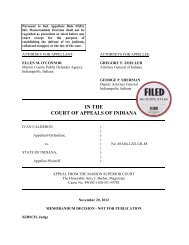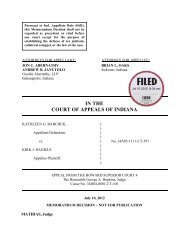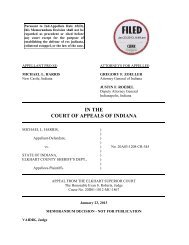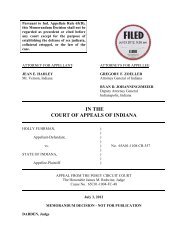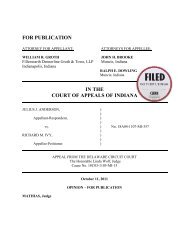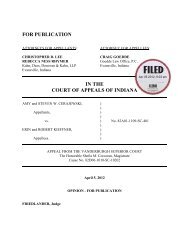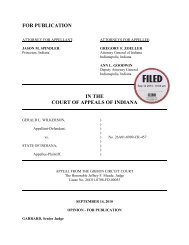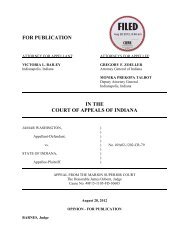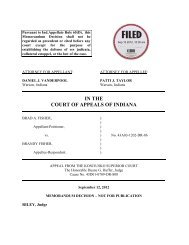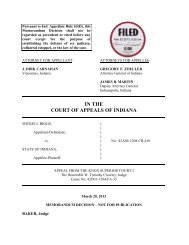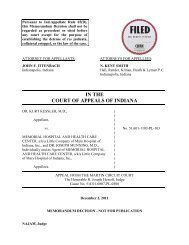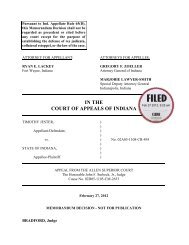David A. Shotts v. State of Indiana
David A. Shotts v. State of Indiana
David A. Shotts v. State of Indiana
Create successful ePaper yourself
Turn your PDF publications into a flip-book with our unique Google optimized e-Paper software.
II. The Fourth Amendment<br />
The Fourth Amendment protects ―[t]he right <strong>of</strong> the people to be secure in their persons,<br />
houses, papers, and effects, against unreasonable searches and seizures.‖ U.S. Const. amend. IV.<br />
In general, the police must have probable cause or a warrant before making an arrest. Herring v.<br />
United <strong>State</strong>s, 129 S. Ct. 695, 698 (2009). To encourage compliance with the Fourth<br />
Amendment, the evidence seized in violation <strong>of</strong> the Constitution must be excluded at trial unless<br />
an exception to this ―exclusionary rule‖ applies. Id. at 699. But the amendment itself ―contains<br />
no provision expressly precluding the use <strong>of</strong> evidence obtained in violation <strong>of</strong> its commands.‖<br />
Arizona v. Evans, 514 U.S. 1, 10 (1995). ―The touchstone <strong>of</strong> the Fourth Amendment is<br />
reasonableness.‖ United <strong>State</strong>s v. Knights, 534 U.S. 112, 118 (2001). Accordingly, even when a<br />
violation occurs, the exclusionary rule does not apply when the police acted in good faith or in an<br />
objectively reasonable manner. Herring, 129 S. Ct. at 701.<br />
<strong>Shotts</strong> raises several Fourth Amendment challenges to his arrest. His principal<br />
contention is that the Alabama warrant was not supported by evidence establishing probable<br />
cause for his arrest, and therefore the <strong>Indiana</strong> arrest was unlawful. He also points to the trial<br />
court‘s finding that ―there was conflicting testimony as to whether the ‗NCIC‘ system<br />
sufficiently indicated that the warrant was active‖ on the date <strong>of</strong> his arrest, and suggests that<br />
there may be an issue whether the warrant was properly entered in the NCIC. <strong>Shotts</strong> also argues<br />
that the <strong>of</strong>ficers did not act in good faith because they did not have a physical copy <strong>of</strong> the<br />
Alabama warrant when they arrested him, and therefore could not determine the warrant‘s<br />
sufficiency and could not reasonably rely on it. <strong>Shotts</strong> also argues that the <strong>Indiana</strong> <strong>of</strong>ficers<br />
should have contacted the Huntsville Police Department rather than the Madison County<br />
Sheriff‘s Department.<br />
A valid arrest warrant must be supported by probable cause. U.S. Const. amend. IV.<br />
Probable cause turns on a ―practical, common-sense decision whether, given all the<br />
circumstances set forth in the affidavit . . . there is a fair probability‖ that the subject has<br />
committed a crime or evidence <strong>of</strong> a crime will be found. Illinois v. Gates, 462 U.S. 213, 238<br />
(1983). To establish probable cause, an affidavit in support <strong>of</strong> the warrant must do more than<br />
state the conclusion <strong>of</strong> the affiant. Giordenello v. United <strong>State</strong>s, 357 U.S. 480, 486 (1958). A<br />
4



